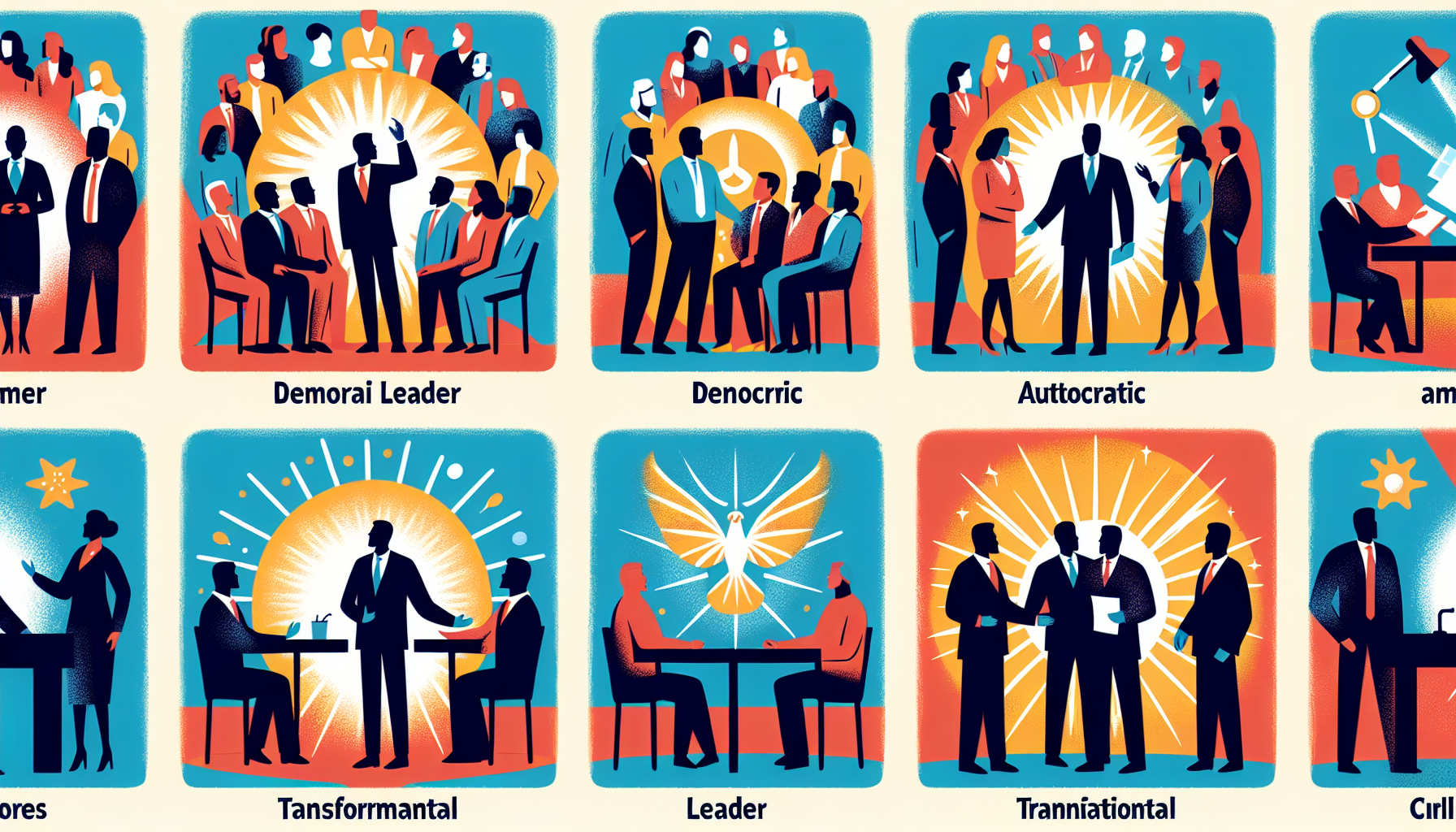What is the best leadership style in the organization? The answer isn’t straightforward – it’s as dynamic as the teams and contexts within which leaders operate. From startups fueled by innovation to established corporations with set procedures, this article unpacks the nuances of various leadership styles and their situational effectiveness. Prepare to navigate through the intricacies of aligning leadership with team needs, work environments, and organizational outcomes.
Key Takeaways
- Leadership style effectiveness depends on various situational factors, including organization size, lifecycle stage, and work environment, rather than being a one-size-fits-all solution.
- Various leadership styles, such as democratic, autocratic, and transformational, have unique advantages and drawbacks, and their appropriateness is contingent upon team dynamics and the nature of work.
- Leaders can enhance their effectiveness through continuous growth, including developing emotional intelligence, self-assessment, mentorship, and aligning their leadership with organizational values and needs.
Evaluating Leadership Styles: What Works Best in Organizations?

Leadership effectiveness cannot be viewed in isolation. Rather, it’s a multifaceted phenomenon influenced by various situational factors like the size of the organization, its lifecycle stage, and the work environment. The impact of leadership practices is also determined by the organizational climate, which is shaped by reward systems, performance standards, and the overall work environment.
A leader’s traits need to align with these situational elements for optimal results. For instance, in a large corporation with well-defined roles and procedures, an autocratic leadership style, characterized by individual control over all decisions, might be effective. In contrast, a small startup may benefit more from a democratic leadership style that encourages team input and fosters innovation.
So, the question is not about finding the most effective leadership style, but rather identifying the most suitable style for your specific context.
The Spectrum of Leadership: Understanding Different Styles

No two leaders are the same, and neither are their leadership styles. Each style has unique approaches to implementing plans, guiding teams, and supervising work. We will delve into various leadership styles and their implications, from democratic and autocratic to transformational leadership.
Democratic Leadership Style
Democratic leadership, also known as participative leadership, is a style that encourages team input and values discussion. This style fosters a sense of ownership among employees, promoting engagement, productivity, and creativity. It’s like a brainstorming session where everyone’s ideas are considered, leading to innovative solutions.
Yet, like all things, democratic leadership has its drawbacks. The emphasis on participation and consensus can introduce delays in decision-making, making it less efficient in urgent situations. Moreover, this style’s effectiveness largely depends on the team members’ expertise, making it less suitable for inexperienced teams.
Nevertheless, in the right context, a democratic leader can utilize democratic leadership as a powerful tool to harness collective intellect and drive innovation.
Autocratic Leadership Style
On the other side of the spectrum is the autocratic leadership style, characterized by individual control over all decisions with little input from team members. An autocratic leader provides a clear chain of command and is beneficial in situations where quick decisions are required.
However, autocratic leadership might not always foster high levels of team member satisfaction. It’s like a one-man show where the leader calls all the shots. This style can be effective in high-pressure situations, like military conflicts, where it can relieve group members from the stress of decision-making. It can also ensure timely project completion in industries like manufacturing and construction, where adherence to safety rules is crucial. That being said, autocratic leadership may not be favorably received in environments that value creativity and independent thinking.
Transformational Leadership Style
Transformational leadership is a style that inspires employees by fostering motivation, emphasizing intellectual stimulation, and promoting a vision that pushes the team to think outside the box. In contrast, the transactional leadership style focuses on achieving set goals and maintaining the status quo. Transformational leaders strive to build a company culture oriented towards the common good, with a strong focus on authenticity, collaboration, and high ethical standards.
Despite its benefits, transformational leadership isn’t without its challenges. The potential for a lack of focus on immediate needs, a poor fit within rigid bureaucratic structures, and the risk of employees underperforming without constant guidance are some potential drawbacks. However, when executed effectively, this style can foster a culture of independence and ownership, particularly crucial in innovative industries like technology.
Matching Leadership to Team Needs

Having examined various leadership styles, we’ll now focus on aligning these effective leadership styles with our team’s needs. After all, a leader’s role isn’t just about leading; it’s about empowering the team to perform their best.
Assessing Team Experience
The experience and skills of your team members play a significant role in determining the suitable leadership style. For instance, a laissez-faire leadership style, characterized by minimal supervision, is more compatible with experienced and skilled team members who are self-starters.
In a laissez-faire leadership setting, the emphasis is on tracking achievements and maintaining open communication lines to ensure alignment. However, this style requires a high level of trust in your team’s abilities. It’s like giving an artist the freedom to create their masterpiece, but checking in regularly to make sure the final piece aligns with the overall vision.
Project Management Considerations
The nature of the work and project management requirements also influence the choice of leadership style. For instance, in crisis scenarios, a coercive leadership style could be effective, while a pacesetting leadership style might be more suitable when the team needs to achieve quick results at critical milestones. Understanding the appropriate management style for each situation can greatly impact the project’s success.
Democratic leadership, which harnesses diverse perspectives and fosters innovation, is particularly effective during the planning phase of a project. On the other hand, transactional leadership, which emphasizes clear timelines and meticulous tracking of goals, enhances the execution phase. Thus, a leader’s ability to switch between different styles based on the project phase can significantly influence its success. In this context, transactional leaders play a crucial role in ensuring timely completion of tasks.
The Impact of Leadership on Organizational Outcomes

In addition to shaping team dynamics, leadership styles profoundly influence organizational outcomes. From driving business success to affecting job satisfaction, the ripple effect of leadership extends throughout the organization.
Employee Retention and Job Satisfaction
Job satisfaction can be significantly impacted by leadership styles. For instance, employee-oriented behaviors, which focus on individual growth and well-being, have a positive effect on job satisfaction. On the contrary, task-oriented styles, which focus more on the task at hand than the individuals performing it, may not always yield similar results.
High emotional intelligence in leaders fosters trust and rapport, essential for a work environment that encourages job satisfaction, motivation, and engagement. Thus, leaders who show empathy and consideration for their employees’ needs can create a more satisfied and motivated workforce.
Driving Company Success
The success of a company is also heavily influenced by leadership styles. Visionary leaders, for example, focus on crafting and operationalizing the company’s future vision, including talent selection, motivation, coaching, and trust-building.
Aligning leadership principles with organizational values can create a synergy that drives the company toward success and inspires a communal pursuit of the vision. Thus, leaders who successfully embody the company’s values and align their leadership styles accordingly can significantly contribute to the company’s success.
Adapting Leadership Styles: When Flexibility is Key

It is evident that varying situations necessitate distinct leadership styles. But how can leaders adapt their style to fit the situation at hand? Enter Situational Leadership – a concept that acknowledges the need for flexibility in leadership.
The Role of Emotional Intelligence
Emotional intelligence is a key quality for leaders, enhancing their effectiveness across different situations. Leaders with high emotional intelligence can engage with employees by soliciting feedback and adjusting their style accordingly, ensuring their approach aligns with the mood and interests of the team.
Such leaders are more effective in building trust and rapport within teams, contributing to a more productive and harmonious work environment. Hence, honing emotional intelligence contributes not only to personal growth but also to becoming a more adept leader.
Balancing Multiple Leadership Roles
Despite the importance of a dominant leadership style, leaders must also juggle multiple leadership roles. For instance, integrating elements of transformational leadership, which focuses on organizational needs, and servant leadership, which prioritizes individual needs, can create a more engaged and motivated workforce.
However, striking the right balance requires strategic thinking and a deep understanding of your team’s needs. By adeptly blending different leadership styles, leaders can ensure that organizational goals are met while also addressing individual employee needs.
Leadership Development: Growing into Your Style
The path to great leadership is a journey, not a fixed endpoint. It involves continuously growing and adapting your leadership style. Let’s explore how leaders can develop their style through emotional intelligence, self-assessment, and mentorship.
Self-Assessment and Feedback
Self-assessment is an invaluable tool that aids leaders in enhancing their self-awareness and understanding their:
- strengths
- weaknesses
- values
- preferences
By reflecting on their professional and personal events, leaders can evaluate their impact and contribute to their growth and leadership style development.
Self-assessment also aids in enhancing leadership skills by:
- Identifying areas for skill development or improvement
- Fostering a culture of continuous improvement within organizations
- Driving organizations towards success
Leaders who regularly engage in self-assessment are more likely to succeed in their roles.
Training and Mentorship
Workplace mentorship promotes an environment of continuous learning and skill development for both mentors and mentees. Through mentorship, leaders can strengthen crucial soft skills such as empathy and open-mindedness, essential for building trust within teams.
Mentorship programs offer several benefits, including:
- Building strong cross-departmental relationships
- Enhancing leadership credibility
- Continuous learning and growth for leaders
- Refining leadership styles and becoming more effective in their roles
Integrating Leadership with Company Values
A leader’s style is not solely about team guidance; it also portrays the company’s values.
Let’s explore how leaders can integrate their style with their company’s values and the role of visionary leaders in this process.
The Role of Visionary Leaders
Visionary leaders are vital in harmonizing leadership with company values. They communicate and embody the company’s values, ensuring their leadership style is congruent with the organization’s culture and direction.
By setting clear intentions through a written statement of values and purpose, visionary leaders foster accountability within their teams. They inspire and motivate their teams by aligning their leadership principles with the company’s values, fostering a strong sense of purpose.
Through their strategic planning and ability to rally teams to buy into the plan, they further align actions with the company’s direction based on feedback.
Summary
Leadership is not about finding a one-size-fits-all style, but rather about understanding the context, acknowledging the team’s needs, and adapting the style accordingly. From democratic to autocratic to transformational, each style has unique strengths and weaknesses. The key to effective leadership lies in choosing the right style for the right situation. So, take the time to understand your team, reflect on your style, and remember – leadership is a journey of continuous learning and growth.
Frequently Asked Questions
What is the best leadership style for an organization?
The best leadership style for an organization is democratic leadership, which emphasizes team participation in decision-making processes and seeks input from team members to create a sense of belonging.
Which type of leadership is typically most effective?
Transformational leadership is often considered the most effective style due to its focus on inspiring and motivating employees to achieve their full potential.
How can I adapt my leadership style to fit my team’s needs?
Consider factors such as your team’s experience, type of work, and project management needs when adapting your leadership style. For instance, a laissez-faire approach may be suitable for experienced and self-starting team members.
What is the impact of leadership styles on organizational outcomes?
Leadership styles have a profound impact on organizational outcomes, significantly influencing job satisfaction, employee retention, and the overall success of the company.
